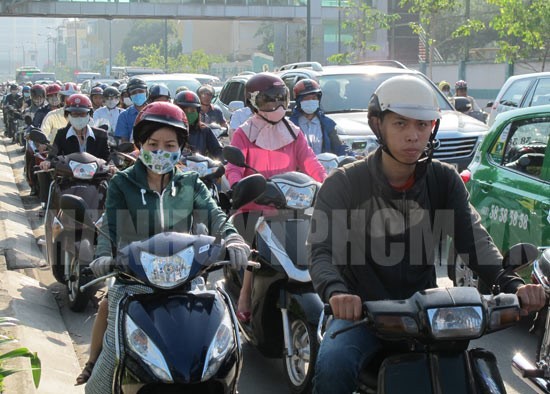
Ho Chi Minh City seeks to improve public transport
Latest
 |
| Ho Chi Minh City seeks to improve public transport. (Source: HCM cpv) |
Le Do Muoi, Director of the Ministry of Transport’s Institute of Transport Strategy and Development, said the city needs to develop the bus network and improve the quality of human resources operating buses.
Priority should be given to developing large capacity public transport, including planned metro routes and a BRT system, he added.
It is vital to control personal vehicle usage in the city, which requires a specific roadmap with consent from residents.
According to Muoi, currently 57 out of 63 provinces and cities across the country operate public bus transport with Hanoi and HCM City having the most developed bus networks.
However, the market share of public bus transport remains very low.
Current public transport in Hanoi meets 17% of local residents’ travel demand, HCM City 9.2%, Hai Phong, Da Nang and Can Tho only 1%, and the remaining cities and provinces below 1%.
Le Trung Tinh, Chairman of the HCM City Passenger Transport Association, said it was vital to restructure the public passenger transport network in the city.
The Department of Transport needs to submit to the People’s Committee a plan to improve public transport in the city, including how to seek investment in public transport, he said.
For the subsidy policy, it is necessary to have a long-term policy such as five or 10 years instead of each year, he said.
In addition, HCM City needs to study about priority roads dedicated to buses to improve bus service, he added.
Vo Khanh Hung, Deputy Director of the Department of Transport, said the city administration in 2020 approved a 400 trillion VND (17.3 billion USD) project to improve access to public transportation and limit the use of personal vehicles over the next decade.
The focus will be on developing the bus network, including enhancing inter-provincial connectivity.
Under the project, public transportation would meet 15% of residents’ travel demand by 2025 and 25% by 2030.
By 2025, the city targets having the bus system connected with new urban areas, industrial parks, satellite urban areas and passenger transport routes.
To improve bus services and increase ridership, the department is expected to open public bidding for bus routes.
As many as 50-60 new routes are expected to start by 2025, increasing to around 75 by 2030, and the number of buses would double in the next 10 years, he said.
Priority will be given to vehicles that use clean and environment-friendly fuels such as CNG, LPG and electricity.
The quality of human resources operating buses will be improved and the management and operation of public transport systems will be modernised.
The city now has 128 routes, including 91 subsidised ones, and nearly 2,109 buses.
Every year, the city provides subsidies of 1 trillion VND (43 million USD) to bus companies.
A new inter-provincial bus route connecting HCM City and the provinces of Long An and Tien Giang will open on August 1.
Nguyen Hong Thanh, Deputy Director of Tien Giang province’s Department of Transport, said the MST 63-1 bus route is being established by the collaboration of three transport departments in the localities involved, and will be operated by Phuong Trang Transport and Tourism JSC.
“This is the first non-subsidised bus route linking to neighbouring localities in the province,” he said.
Bus ticket prices are from 12,000-70,000 VND (0.5-3 USD) per trip, depending on the distance of travelling. Subsidised tickets for students in Tien Giang are only 7,000 (0.3 USD) per trip.
The route will start from Tan Phu Bus Station in HCM City’s Tan Phu district, run through Long An province, and stop at Tien Giang Bus Station in Tien Giang province’s My Tho city.
It will operate between 5am and 6pm daily.
The buses running on this route are allowed to pick up and drop off passengers at all existing public bus stops in HCM City and Tien Giang.
In Long An, they are only allowed to pick or drop off passengers at Vinh Loc 2 Industrial Park, Ben Luc Economic and Technical Intermediate School, Ben Luc Market, the crossroads on the bypass around Tan An city and Long An Pedagogical College.





















